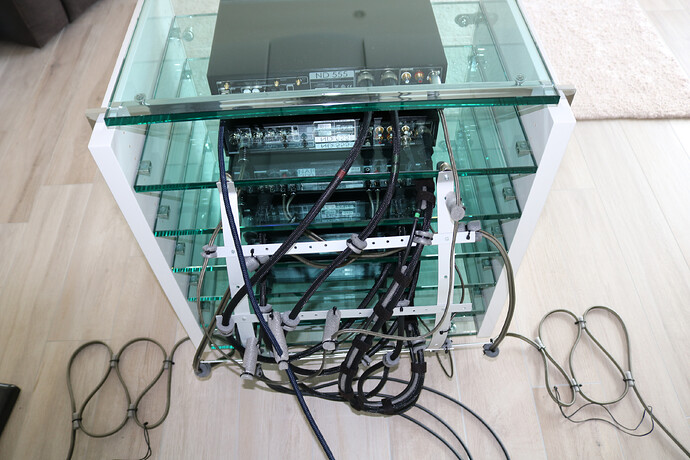Surely easier said than done, especially if you have more boxes and a tight space at the rear of the components.
I was told by the dealer I bought my s/h 252 from to loop the SNAIC around the Burndy a few times so they stay together. That’s how I have it now. When my 300DR arrives in a couple weeks I plan to rebuild my brain/brawn Fraims and re-site/re-dress everything.
It would be nice to have a FAQ on cable best practices.
Yep, a definitive guide is needed, it is bad enough trying to figure out the naming conventions used with our beloved Naim interconnects and components 
This is how I loop it twice on the cable. But somehow feel it is wrong and stressing too much on the cable. Some says need to go in parallels and just briefly touch will do.
THat’s what I’m doing. The only difference is my SCDR and 252 are on different racks so they hang differently, but I twisted the SNAIC around the Burndy like you did.
Also leave all Din connector nuts loose and pull back 1mm from being fully in.
Make sure you have one or more Dreamcatchers in the room as well.
Oh you mean the DIN is not supposed to be tighten? As in do not twist the locking mechanism? I tighten all my DIN btw.
I purchased 0.5m cables for the psu as it’s one shelf below the SN2. Might not be ideal but reduces the spaghetti behind the boxes.
Thought about getting the hiline shortened by 300mm as it would then hang free - which is worse slightly shorter or touching and clashing with equipment/cables…
My advice is to run the SNAIC and Burndy as closely parallel to one another as possible without touching. If that’s not possible then one loop (to keep the SNAIC close to the Burndy but minimise actual contact) is fine.
You want the burndy to be as unstressed as possible. A trick is to hold to by the connectors in each hand, with each connector orientated exactly like the sockets, and then gently swing the cable while twisting the connectors slightly. You should then end up with a cable that is “formed” to fit easily straight into the sockets. This gives very real performance benefits.
AFAIK, Naim don’t do SNAICs shorter (or longer) than standard 1.25m, this being the optimum length.
Wow tks for this definitive answer. So I guess mine is totally wrong and stressful to the cable. I should re-dress to the following:
- Run the 2 cables in parallel as close but not touching. The key point here is not touching as the Pre-amp manual also did not mention touching but do mention as “close” as possible.
Sometimes, try as you might, it can be difficult to get them nicely parallel. If that’s the case, then a single loop of the SNAIC over the Burndy should help, but don’t do any more than that if possible.
Interestingly the usual advice for cables dressing is to leave them loose, hanging. The goal being to avoid mechanical stress.
I’m a bit dubious about such a solution.
Hanging cables undergo a permanent stress, caused by a permanent force: gravity.
I use quite a different approach. I gently shape the cables, then attach them to an aluminium structure I tinkered. The cables then “rest” on foam loops which are attached to that structure. The cables never touch the rack, nor the floor (except for the PowerLines). This probably leaves some mechanical stress, but really not much. Like such:
(This is an old picture. I did some optimisations when I installed the NAP500DR)
Burndy and SNAIC from the NAC552DR run parallel to each other without touching one another.
Speaker cables simply hang on the air, touching nothing, using cheap threads.
May I said this is the best Burndy and SNAIC parallel dressing I see. Totally parallel and not touching. I got to find the foam to do it myself! Tks for sharing the picture.
Thanks! It was quite a puzzle…
Additionally, if you check the picture, the cables never touch each other and do never run parallel, except for the NAC’s Burndy and Snaic, of course.
Serious speaker cable artistry going on above, but in my own setup I prefer to lose the excess with 2 or 3 loose coils. This may add a small amount of inductance, making the cable appear slightly longer to the amp - which may explain why I prefer it. The PE ‘lifters’ are a recent introduction and even though I secretly wished they’d be totally without effect (the damned engineer in me) I now stare at them in disbelief.
I’ve had the same thoughts - wouldn’t decoupled connectors need to be supported in some way to stop the decoupled plugs from permanent stress from the cable hanging free?
It’s hard enough doing A/Bs for components/cables I find sometimes, let alone fiddling with different methods of cable dressing when access to the equipment is not as good as you’d like or plain tricky!
I think it’s more down to minimising stress within the cables themselves. And perhaps also avoiding microphonics feeding back into the cable. This may be why any touching of the cables or securing to anything usually sounds worse. A useful thing to ponder: if it sounded better then very likely Naim would have already adopted it. So if they haven’t it’s worth asking why not (hint: the answer is usually because it sounds worse).





